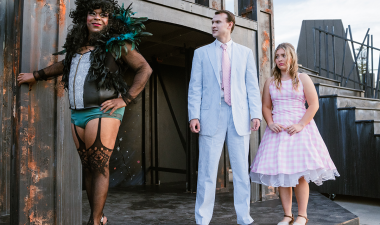When she signed up for a required course in community policing at the Stockton Campus last fall, Stanislaus State criminal justice major Anahit Corona did so because it was taught by Assistant Professor of Criminal Justice Sebastian Sclofsky, whom she’d enjoyed learning from in other classes.
But when Sclofsky told the students that the course involved each of them volunteering at Stockton’s St. Mary’s Dining Room, Corona admitted to being a bit nervous.
She’d been to St. Mary’s and the Stockton Shelter for the Homeless, which sit side by side, as a child when her church volunteered at the family shelter, handing out blankets and sweaters or serving warm food.
“I was kind of scared at first,” Corona said. “I wasn’t familiar with the dining room itself. When the instruction was given, I felt more at peace.”
Sclofsky didn’t include the service-learning project in the course to scare off students like Corona, who is completing her final semester and thinking about working in an area of criminal justice that addresses child and sexual abuse, but to provide them with real-world experience.
“My approach since I began teaching this class is to find organizations that are dealing with some type of issue going on in the community that is somehow related to the work of criminal justice, but not related to the agencies of criminal justice,” said Sclofsky, who was hired in 2018 to teach predominantly in Stockton, although he teaches at both campuses.
“The goal is for students to learn about problems in the community and to see how the community is organizing to respond to those problems.”
In Stockton, as elsewhere, homelessness is a dire problem. Sclofsky was already researching homelessness and criminal justice, so naturally, he reached out to agencies offering support to that population.
Karen Gonzales, St. Mary’s volunteer coordinator, responded. With assistance from Stan State’s Julie Fox and her team in the Office of Service Learning, Sclofsky was able to connect his students with the agency that serves breakfast, lunch and dinner seven days a week to more than 700 individuals a day and provides medical, dental and hygiene services.
Sclofsky, his wife and two sons had volunteered a few times at St. Mary’s before he asked his students to do the same.
The assignment wasn’t about serving food or washing dishes. It fit into the context of the course.
“The theory of community policing, as opposed to its practice, is that the community, including the police, collaboratively identifies the main problems,” Sclofsky said. “This involves deciding which problems require and do not require policing to address some of those issues.”
His students study the theory of community policing and how it has been implemented in this country, which includes the way homelessness has become an issue for law enforcement.
“The police have very little ability to solve it, not because they’re incompetent or wouldn’t like to solve it,” Sclofsky said. “Most police officers in a community are trying to help in some way, but it’s a very difficult problem to solve with the tools they have.
Understanding the processes and challenges behind community policing is important for criminal justice students to understand, as well as the forces driving these challenges, according to Sclofsky.
“The students experience firsthand what St. Mary’s is doing, then they can take a couple steps back to analyze, reflect and ask the question of why police must deal with this problem and whether that is best approach. That’s what I try to push my students to think about.”
It worked for Corona, who said her time spent at St. Mary’s included handing out water, serving from the food line and putting together cutlery and napkins.
She also engaged in conversations with other volunteers, some of them homeless themselves.
One man told her he’d been arrested by a friend, who became a police officer. He didn’t hold a grudge, because he knew his friend was doing his job and that he was in the wrong. The two are Facebook friends. The man encouraged Corona to pursue law enforcement, saying he thought she had the heart for it.
Her heart certainly opened after this service-learning project.
“It increased my sympathy after hearing their stories,” she said. “One of the people I spoke to doesn’t know how to read or write. He was working all the time and didn’t learn. He spoke with sadness. His kids told him he was dumb because he couldn’t read or write. I didn’t agree he was dumb. We take for granted something others don’t have. It makes me think about humanity and about what people are going through.”
Corona gained the insight Sclofsky had hoped for.
“I’ve heard alternate perspectives. I have family members and friends who don’t agree with helping people who are homeless.”
She also gained an understanding of how some people end up homeless and what their lives are like.
In that way, Corona aced her assignment, but Sclofsky recognizes another value in students volunteering.
“Universities should be a place for the construction of citizenship, and these types of service-learning experiences are a good way to get students involved in the community. In this case, they are trying to understand from a criminological and policing perspective and a social perspective. I hope we push our students enough to be able to process and think about it.”



